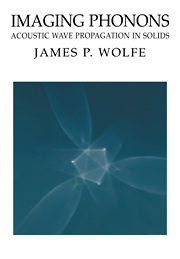Book contents
- Frontmatter
- Contents
- Preface
- Prologue – Anisotropic heat flow in crystals
- 1 Ballistic heat pulses and phonon imaging – A first look
- 2 Phonon focusing
- 3 Generation and detection of phonons – Experimental aspects
- 4 Focusing in cubic crystals
- 5 Acoustic symmetry and piezoelectricity
- 6 Lattice dynamics
- 7 Imaging of dispersive phonons
- 8 Phonon dynamics
- 9 Bulk scattering of phonons – Experiments
- 10 Quasidiffusion and the phonon source
- 11 Phonon scattering at interfaces
- 12 Refraction and reflection at solid/solid interfaces – Experiment
- 13 Imaging ultrasound in solids
- 14 Imaging surface acoustic waves
- 15 Interactions of ballistic phonons with electrons
- Appendix I Algebraic solution to the wave equation
- Appendix II Abbreviated tensor notation and group velocity
- Appendix III Survey of phonon focusing in cubic crystals
- Index
15 - Interactions of ballistic phonons with electrons
Published online by Cambridge University Press: 24 March 2010
- Frontmatter
- Contents
- Preface
- Prologue – Anisotropic heat flow in crystals
- 1 Ballistic heat pulses and phonon imaging – A first look
- 2 Phonon focusing
- 3 Generation and detection of phonons – Experimental aspects
- 4 Focusing in cubic crystals
- 5 Acoustic symmetry and piezoelectricity
- 6 Lattice dynamics
- 7 Imaging of dispersive phonons
- 8 Phonon dynamics
- 9 Bulk scattering of phonons – Experiments
- 10 Quasidiffusion and the phonon source
- 11 Phonon scattering at interfaces
- 12 Refraction and reflection at solid/solid interfaces – Experiment
- 13 Imaging ultrasound in solids
- 14 Imaging surface acoustic waves
- 15 Interactions of ballistic phonons with electrons
- Appendix I Algebraic solution to the wave equation
- Appendix II Abbreviated tensor notation and group velocity
- Appendix III Survey of phonon focusing in cubic crystals
- Index
Summary
The phonon is an elementary excitation of a crystal. How it couples to other elementary excitations is critical to many areas of condensed-matter physics. Foremost are the interactions of phonons with electrons. In this final chapter, I will touch upon a few emerging technologies and applications of phonon imaging that mainly involve the interactions of electrons and phonons. The topics chosen include the optical properties of semiconductors and heterostructures, mechanisms of superconductivity and development high-energy particle detectors.
Of course, we have already encountered the interaction of nonequilibrium phonons with electrons. Chapter 10 dealt with the spatial and frequency distributions of phonons created by photoexcited carriers in semiconductors. In contrast, an increasing variety of experiments employ ballistic phonons to probe both intrinsic electronic states and those associated with impurities. In addition, it is possible in some cases to detect nonequilibrium phonons by their effect on the optical and electronic properties of crystals. We begin by considering a few crystalline systems that are suitable for time- and space-resolving phonon detectors, while keeping in mind the broader goal of elucidating the physics of new materials or devices.
Optical detection of nonequilibrium phonons
For the most part, the optical properties of crystals in the visible or nearinfrared region are associated with transitions between electronic states. Phonons of sufficient energy can induce transitions between low-lying electronic states, thereby affecting the optical absorption or emission of the solid.
- Type
- Chapter
- Information
- Imaging PhononsAcoustic Wave Propagation in Solids, pp. 379 - 398Publisher: Cambridge University PressPrint publication year: 1998



